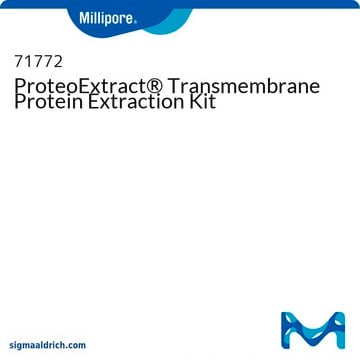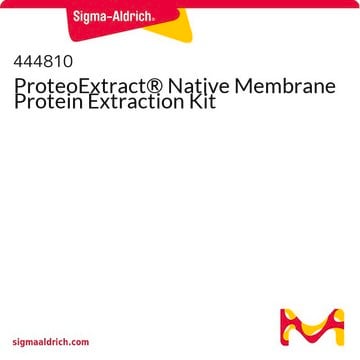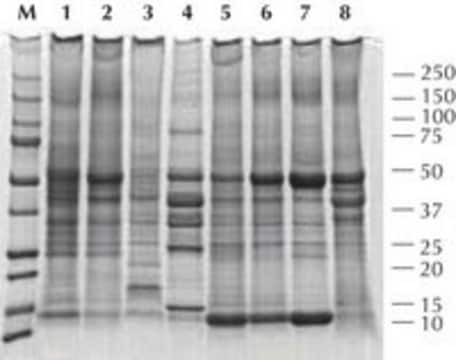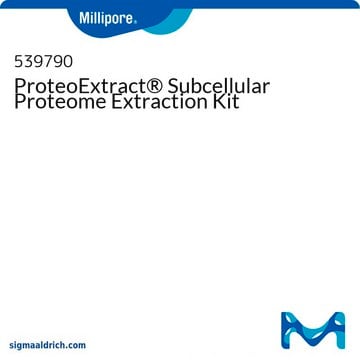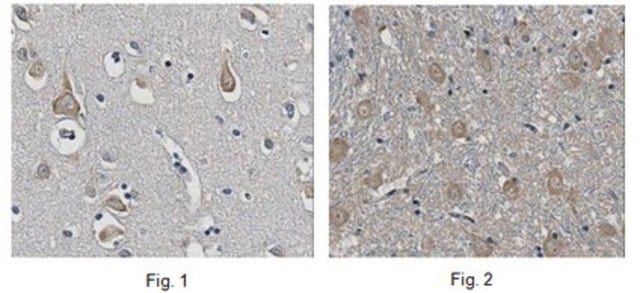CE0050
CelLytic™ MEM Protein Extraction Kit
Sinónimos:
Membrane protein extraction kit
Iniciar sesiónpara Ver la Fijación de precios por contrato y de la organización
About This Item
UNSPSC Code:
41116134
NACRES:
NA.56
Productos recomendados
Categorías relacionadas
General description
CelLytic™ MEM Protein Extraction Kit offers a fast and convenient method to isolate hydrophobic and raft microdomain associated proteins from cells. The method is based on phase separation and does not require cell membrane isolation. The separated proteins can be used for further experiments such as SDS-PAGE, Western blotting, dot blotting, and immunoprecipitation. The kit has been tested on, but not limited to, HeLa, HEK-293, NIH 3T3, COS and CHO cell lines.
Membrane proteins make up around 20-30% of an organism′s genome and serve as cellular gatekeepers, regulators, and sensors. They have diverse cellular functions, such as shielding the cell from external toxins, being the starting point of intracellular signaling cascades, and retaining critical ion concentrations.
Application
CelLytic™ MEM Protein Extraction Kit has been used for de novo lipogenesis measurements using hepatocytes and to extract membrane proteins for western blotting.
Suitability
Sufficient reagents supplied for 80 tests.
Legal Information
CelLytic is a trademark of Sigma-Aldrich Co. LLC
Solo componentes del kit
Referencia del producto
Descripción
- Lysis and Separation Buffer 50 mL
- Wash Buffer for CelLytic MEM 50 mL
- Sodium Chloride, 4M Solution 1.5 mL
Los componentes del kit también están disponibles por separado
Referencia del producto
Descripción
SDS
- P8340Protease Inhibitor Cocktail, for use with mammalian cell and tissue extracts, DMSO solution 1 mLSDS
signalword
Warning
hcodes
Hazard Classifications
Eye Irrit. 2 - Skin Irrit. 2
Storage Class
10 - Combustible liquids
flash_point_f
188.6 °F - closed cup
flash_point_c
87 °C - closed cup
Certificados de análisis (COA)
Busque Certificados de análisis (COA) introduciendo el número de lote del producto. Los números de lote se encuentran en la etiqueta del producto después de las palabras «Lot» o «Batch»
¿Ya tiene este producto?
Encuentre la documentación para los productos que ha comprado recientemente en la Biblioteca de documentos.
Los clientes también vieron
Tomoaki Furuta et al.
Cancer science, 112(9), 3722-3731 (2021-06-12)
The rBC2LCN lectin, known as a stem cell marker probe that binds to an H type 3 fucosylated trisaccharide motif, was recently revealed to also bind to pancreatic ductal adenocarcinoma (PDAC) cells. A lectin-drug conjugate was generated by fusing rBC2LCN
Willy Morelle et al.
The Journal of clinical endocrinology and metabolism, 102(4), 1375-1386 (2017-03-23)
TMEM165 deficiency is a severe multisystem disease that manifests with metabolic, endocrine, and skeletal involvement. It leads to one type of congenital disorders of glycosylation (CDG), a rapidly growing group of inherited diseases in which the glycosylation process is altered.
Hiroaki Tateno et al.
Glycobiology, 26(12), 1328-1337 (2016-04-03)
Human somatic stem cells such as human mesenchymal stem cells (hMSCs) are considered attractive cell sources for stem cell-based therapy. However, quality control issues have been raised concerning their safety and efficacy. Here we used lectin microarray technology to identify
Sushmitha Vijaya Kumar et al.
Scientific reports, 10(1), 14985-14985 (2020-09-13)
Membrane organization plays an important role in signaling, transport, and defense. In eukaryotes, the stability, organization, and function of membrane proteins are influenced by certain lipids and sterols, such as cholesterol. Bacteria lack cholesterol, but carotenoids and hopanoids are predicted
Yue Zhao et al.
Cancer medicine, 7(8), 3977-3987 (2018-07-06)
Esophageal squamous cell carcinoma (ESCC) is a malignant disease with poor prognosis. Because of early metastasis prior to diagnosis and therapeutic resistance, ESCC has become one of the leading causes of cancer-related death. Here, we investigated the clinicopathological significance of
Nuestro equipo de científicos tiene experiencia en todas las áreas de investigación: Ciencias de la vida, Ciencia de los materiales, Síntesis química, Cromatografía, Analítica y muchas otras.
Póngase en contacto con el Servicio técnico

